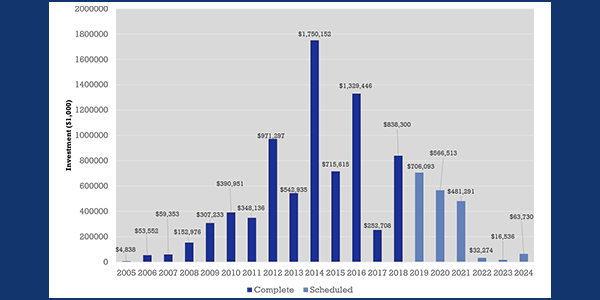DES MOINES, Iowa — SPP’s Strategic Planning Committee last week debated the merits of deterministic versus probabilistic planning approaches during a review of the RTO’s transmission investments.
Lanny Nickell, SPP’s vice president of engineering, told the SPC during its July 15 meeting that his staff use the industry’s standard deterministic approach, which requires that a single component’s outage does not cause system instability, thermal overloading, load curtailment or cascading outages. Critics say the approach does not adequately consider all the possibilities that arise during an event.
Probabilistic planning evaluates a range of possible outcomes but is more expensive than the deterministic approach. Nickell said a 2013 assessment of the approach estimated it would cost about $275,000 to develop probabilistic planning concepts, and another $2 million to develop and implement the software systems needed.
Nickell pointed out that SPP’s Integrated Transmission Planning (ITP) studies have performed “selective sensitivities” on the portfolios’ final assessments, including ranges for wind energy, gas prices and load growth. He also reminded the committee of the RTO’s 2016 transmission-value study, which indicated that for every $1 of transmission investment made in 2012-2014, members could expect at least a $3.50 benefit to ratepayers. (See SPP Begins Promotional Campaign to Tout Transmission Value.)
SPP’s transmission planning process has resulted in $7.7 billion in completed projects. Another $1.9 billion in projects have been approved.
If anything, Nickell said, SPP tends to be conservative when planning transmission buildouts.
“When building an ITP portfolio, our benefit-to-cost [studies] tend to be lower. We don’t do a lot of what-if scenario analyses,” he said, noting the 2019 scope’s reference case and emerging-technologies case are fairly similar. “I don’t think it’s too far out of the realm from what we’ve seen in the past. If the world dramatically changes, what will that mean? We don’t know until we study it.”
Golden Spread Electric Cooperative’s Mike Wise, the SPC’s vice chair, praised SPP’s work in creating an “uncongested, reliable system,” but he said current practices may need to change.
“Going further than what we’ve done requires a real stretch of the imagination,” he said. “I’m concerned we’re going to look back and say, ‘Did we make a quality decision to ensure we understand the probability of regret?’”
SPP CEO Nick Brown agreed with comments about future uncertainty, saying, “We’re woefully inaccurate in terms of how we look at the future.”
“We, as an industry, should be spending a lot more time than we do on transmission planning,” he said. “I think it’s time we move into a probabilistic approach to transmission planning.”
To increase planning confidence, Nickell said SPP could increase the minimum benefit-cost threshold for approval from 1.05 to 1.25, reduce the financial analysis time frame and perform more frequent assessments with real-time data, as it did with its transmission-value study.
SPP Chairman Larry Altenbaumer said the RTO has built a strong foundation with its planning processes, “but we can’t let that blind us moving forward.”
Altenbaumer said the Value and Affordability Task Force (VATF), which he chairs, is also looking at the issue. The discussion will continue there, he said.
Expansion the Top Strategic Priority
The SPC also reviewed feedback from its May planning retreat, during which members were asked to determine which strategic initiatives should be actively pursued.
Committee members identified the top three priorities as:
- Expanding SPP’s 14-state footprint, both east and west.
- Implementing the Holistic Integrated Tariff Team’s recommendations shared with the Markets and Operations Policy Committee.
- Implementing the VATF’s recommendations. The task force was formed in January to review the cost recovery of transmission investments as well as the ongoing benefit from those investments and SPP’s operation. (See “Altenbaumer Continues to Exert his Influence,” SPP Strategic Planning Committee Briefs: Jan. 16, 2019.)
Staff said the SPC members’ consensus was that continuing to seek opportunities to provide services and develop markets “would add tremendous value and benefit to SPP’s current stakeholders.” The feedback indicated expansion “must be considered strategically and proactively while minimizing the cost to existing members,” staff said.
The SPC also identified other priorities as expanding services within SPP, a continued focus on cybersecurity, taking a lead role in applying battery storage, better integrating renewables and resolving issues that prevent the export of renewable or other low-cost generation.
The SPC will share its feedback with the Board of Directors and Members Committee during their July meeting.
— Tom Kleckner





